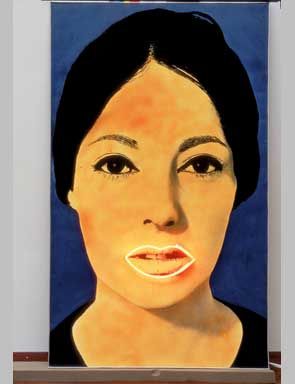'The Avant-gardes '20 / '60' @ Van Gogh Museum
High voltage painting, Martial Raysse, Stedelijk Museum Amsterdam, c/o Pictoright Amsterdam 2009
AMSTERDAM.-Prior to its reopening in spring 2010 the Stedelijk Museum will once again feature as a special guest exhibition in the Van Gogh Museum from 26 June to 23 August, 2009. The Avant-gardes '20 / '60 exhibition shows highlights from the Stedelijk Museum's collection from the Twenties and the Sixties of the previous century: turbulent decades which saw many major shifts - including in the visual arts. These years were characterized by a strong drive towards experimentation in art. Artists created groundbreaking works, using new materials. They regarded themselves as the vanguard, as innovators - literally as the 'avant-garde' of the visual arts and of society. Some 74 major works by artists such as Pablo Picasso, Piet Mondriaan, Kazimir Malevich, Luciano Fontana, Yves Klein, Roy Lichtenstein and Andy Warhol will be on show in the museum's exhibition wing.
Avant-gardes '20 - During the Twenties, the avant-garde still operated almost exclusively in Europe. Picasso, Mondriaan, Van Doesburg, Schwitters and Malevich are some of the key exponents of the avant-garde of that time. Paris remained the epicentre of artistic innovation that it had long been, thanks to the late Cubism of Picasso and the Surrealism of, for example, Max Ernst. In cities like Berlin, Dessau and Hanover too, a radically new aesthetic emerged, expressed in movements such as Dada and Bauhaus. In Western Europe the Netherlands also played an important role, with the flowering of the De Stijl movement in cities such as Leiden and Utrecht. And much further to the east, in Moscow and Leningrad, revolutionary new movements came into being that were to become known as Russian Constructivism.
Avant-gardes '60 - Forty years later the centres for key developments within the avant-garde had shifted to the United States, particularly in New York and Los Angeles. The land of unlimited opportunity gave birth to movements such as pop art, minimal art and post-minimal art, with artists such Andy Warhol, Carl Andre and Robert Morris. In Western Europe Paris remained an important centre, with its representatives of the nouveau réalisme, while the utilitarian use of form practiced by artists' collectives such as Zero and Nul came to the fore in Germany and the Netherlands. Once again specific cities played an important role, especially Düsseldorf, Cologne and Amsterdam.
The role of the Stedelijk Museum - After the Second World War, Amsterdam functioned as a sort of transatlantic bridge: many American artists staged their first museum presentations here, thereby gaining a foothold in Western Europe. In this process the Stedelijk Museum often played a unifying role. In doing so, it succeeded in building up a leading collection. As a result the majority of the works on show here featured frequently in the Stedelijk Museum's permanent display until the museum’s building on the Museumplein closed five years ago.
Towards a new Stedelijk Museum - The Stedelijk Museum is currently being extensively renovated and expanded with a spectacular new extension by Benthem Crouwel Architects. The Stedelijk Museum is scheduled to reopen in March/April of 2010. Until then it is staging projects and exhibitions throughout Amsterdam, under the slogan Stedelijk in the City.
Blue Green Red, 1964-1965, Elsworth Kelly. Stedelijk Museum Amsterdam

/https%3A%2F%2Fprofilepics.canalblog.com%2Fprofilepics%2F1%2F0%2F100183.jpg)




/http%3A%2F%2Fstorage.canalblog.com%2F69%2F57%2F119589%2F64370738_p.jpg)
/http%3A%2F%2Fstorage.canalblog.com%2F36%2F03%2F119589%2F64361206_p.jpg)
/http%3A%2F%2Fstorage.canalblog.com%2F56%2F92%2F119589%2F61703506_p.jpg)
/http%3A%2F%2Fstorage.canalblog.com%2F34%2F00%2F119589%2F61670151_p.jpg)